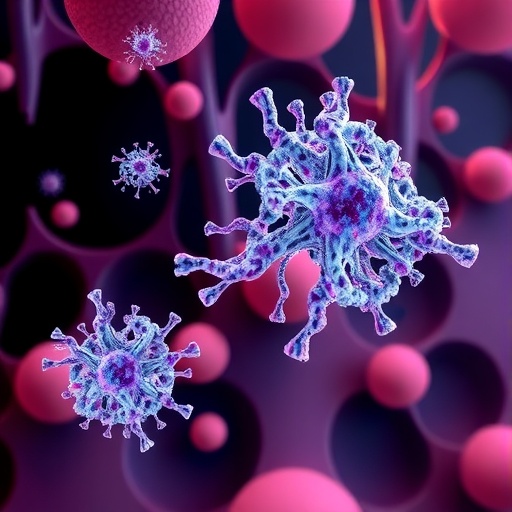
In a groundbreaking study poised to reshape our understanding of microbial adaptability, researchers have unveiled the discovery of a colossal extrachromosomal genetic element named “Inocle” within the human oral microbiome. This giant DNA structure, far exceeding previously characterized mobile genetic elements in size, has been identified as a potential catalyst for expanding the adaptive landscape of oral bacterial communities. The implications of such a finding ripple through the fields of microbiology, genomic evolution, and human health, opening new frontiers in deciphering how microorganisms seamlessly adjust to ever-changing environments within the oral cavity.
The human mouth harbors one of the most intricate and diverse microbial ecosystems known, teeming with hundreds of bacterial species that coexist and interact in complex webs. These microbial residents engage in constant genetic exchanges to survive challenges such as host immune responses, fluctuating nutrient availability, and antimicrobial interventions frequently encountered in this habitat. Traditional models have emphasized the role of plasmids, bacteriophages, and transposons as vehicles facilitating horizontal gene transfer. However, the revelation of the Inocle element introduces a previously unappreciated level of genomic architecture that could underpin adaptive plasticity at a scale never before documented.
Inocle stands out not merely by its size but also by its sophisticated genetic composition, as elucidated through state-of-the-art sequencing and bioinformatic analyses. Spanning hundreds of kilobases—many times larger than typical plasmids—this element is packed with an array of genes encoding functions ranging from metabolic versatility and antibiotic resistance to interbacterial communication and environmental sensing. Its sheer genetic payload suggests a modular design, enabling recipient bacteria to swiftly acquire multi-trait advantages in response to selective pressures, a mechanism that could redefine microbial survival strategies.
.adsslot_kwmRQU6AnH{width:728px !important;height:90px !important;}
@media(max-width:1199px){ .adsslot_kwmRQU6AnH{width:468px !important;height:60px !important;}
}
@media(max-width:767px){ .adsslot_kwmRQU6AnH{width:320px !important;height:50px !important;}
}
ADVERTISEMENT
One of the most astonishing features discovered within the Inocle element is the presence of multiple integrative and conjugative systems, which facilitate its mobility between bacterial hosts. This mobility hints at an evolutionary strategy allowing broad dissemination of adaptive traits across various oral microbial taxa. Furthermore, the element contains sophisticated regulatory circuits that ensure its stable replication and maintenance within hosts, minimizing fitness costs typically associated with large genetic elements. These findings point toward a highly evolved symbiotic relationship, balancing mutual benefit and genetic burden.
The research team employed cutting-edge metagenomic approaches to isolate and characterize Inocle from saliva and plaque samples collected from diverse human cohorts. Advanced long-read sequencing technologies were instrumental in resolving the full-length architecture of this element, overcoming historical limitations posed by its size and repetitive regions. Comprehensive phylogenetic analyses further illuminated its mosaic origins, revealing contributions from distinct bacterial lineages and underscoring the dynamic evolutionary processes shaping the oral microbiome.
Beyond the fundamental biology, the discovery of Inocle carries profound clinical implications. The oral microbiome plays a pivotal role not only in oral health but also in systemic conditions, influencing cardiovascular diseases, diabetes, and even neurodegenerative disorders via complex host-microbe interactions. The ability of Inocle to shuttle multifunctional traits, including antibiotic resistance genes, raises concerns regarding the emergence and rapid spread of resistant pathogens in the oral cavity, complicating treatment strategies and infection control measures within dentistry and beyond.
Moreover, the revelation of Inocle challenges existing paradigms about the scale and complexity of mobile genetic elements in microbial communities. The traditional categorization of extrachromosomal elements may require revision to accommodate such giant entities, heralding a new class of “megaplasmids” or “giant integrative elements” with unique evolutionary trajectories. This insight compels microbiologists to revisit models of horizontal gene transfer dynamics and consider expanded genomic surveillance pipelines to detect these elements across diverse habitats.
The study also sheds light on the environmental triggers and selective landscapes that may drive Inocle mobilization and maintenance. Evidence suggests that fluctuations in oral conditions—such as pH changes, nutrient fluxes from diet, and host immune fluctuations—could activate regulatory networks encoded within Inocle, prompting its transfer among cohabiting bacteria. Understanding these triggers could pave the way for targeted interventions disrupting the dissemination of detrimental traits, offering novel avenues for oral disease prevention.
Intriguingly, the presence of Inocle also raises questions about the co-evolutionary mechanisms between host and microbiome. The balance between microbial adaptability and host tolerance is finely tuned, with large mobile elements like Inocle potentially tipping this equilibrium. Future research may explore whether Inocle elements contribute to beneficial traits that enhance host health or if they predominantly act as vectors of pathogenic potential. These dualistic roles underscore the complexity of host-microbe interplay.
The research further opens exciting prospects for biotechnology and synthetic biology. Harnessing the modular design and transferability of giant elements like Inocle could enable engineered delivery systems for beneficial genes or metabolic pathways to oral commensals, with applications ranging from targeted antimicrobial delivery to biofilm modulation. Understanding the mechanisms governing Inocle inheritance and expression is thus critical for translating these insights into tangible therapeutic innovations.
The multi-disciplinary approach combining microbial ecology, genomics, computational biology, and clinical sampling exemplifies the power of integrated research frameworks to unravel complex microbial phenomena. The authors emphasize that the interdisciplinary collaboration was key to overcoming challenges inherent in studying such large and cryptic genetic elements within naturally occurring microbial consortia, setting new standards for future microbiome research.
Despite these advances, numerous questions about Inocle remain. The full spectrum of its distribution across global populations, its prevalence in health versus disease states, and its impact on microbial community structure and function require extensive longitudinal and experimental investigations. Addressing these knowledge gaps demands development of novel molecular tools and experimental models tailored to giant extrachromosomal elements.
In conclusion, the unveiling of Inocle adds a monumental piece to the puzzle of microbial adaptation and evolution within the human oral ecosystem. Its colossal size, genetic complexity, and mobility highlight previously underappreciated dimensions of microbial ingenuity. As microbiologists delve deeper, Inocle may well represent the tip of an iceberg of giant genetic elements shaping microbial life on and within us, with profound implications for medicine, evolution, and biotechnology.
The legacy of this discovery underscores a broader principle: microbial genomes are far more dynamic and flexible than traditionally conceived, continuously inventing new ways to thrive in fluctuating environments. Unraveling such phenomena not only deepens fundamental biological understanding but also empowers humanity to better manage the microbial world intrinsically linked to our health and well-being. The journey to decode Inocle and its kin is only beginning, promising transformative insights for years to come.
Subject of Research: The identification and characterization of a giant extrachromosomal genetic element, “Inocle,” within the human oral microbiome and its role in microbial adaptation.
Article Title: Giant extrachromosomal element “Inocle” potentially expands the adaptive capacity of the human oral microbiome.
Article References:
Kiguchi, Y., Hamamoto, N., Kashima, Y. et al. Giant extrachromosomal element “Inocle” potentially expands the adaptive capacity of the human oral microbiome. Nat Commun 16, 7397 (2025). https://doi.org/10.1038/s41467-025-62406-5
Image Credits: AI Generated
Tags: adaptive plasticity in bacteriaadvancements in microbiome studieschallenges in oral microbiotacomplex microbial ecosystemsgenetic exchanges in microbiologyGiant extrachromosomal genetic elementhorizontal gene transfer mechanismshuman oral microbiome researchimplications for genomic evolutionInocle element discoverymicrobial adaptability in healthoral bacterial communities evolution





